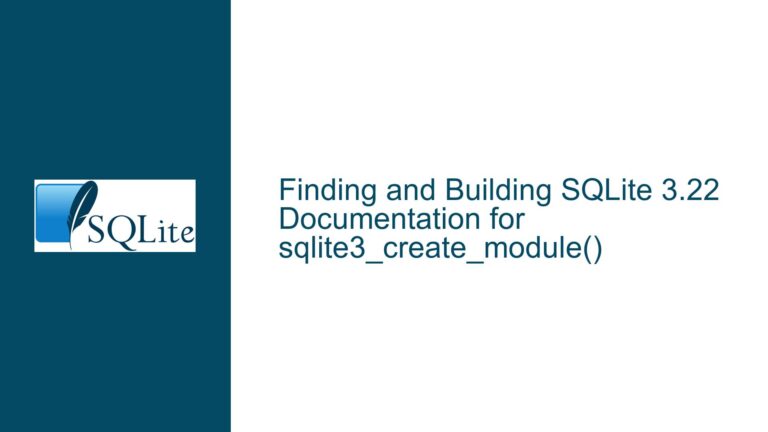Handling SQLite Query Parameters: Interactive Prompting and Binding Workarounds
Understanding Parameter Binding Challenges in the SQLite CLI
The SQLite command-line interface (CLI) is a powerful tool for interacting with databases, but its handling of query parameters can be unintuitive for users accustomed to interactive workflows. A common frustration arises when executing parameterized queries (e.g., SELECT ? + 1 or SELECT :x + 1), where the CLI does not prompt users to input values for parameters at runtime. Instead, parameters must be preconfigured using the .param command family. This design adheres to SQLite’s prepare-bind-execute sequence but creates friction for ad hoc testing or iterative query refinement.
Key Pain Points
- Pre-Binding Requirement: Parameters must be bound before preparing and executing a statement. The
.paramcommands (e.g.,.param set,.param list) allow users to define named or positional parameters, but these values persist across queries unless explicitly cleared. - Silent NULL Substitution: Unbound parameters default to
NULL, which can lead to unexpected results if users forget to update or clear parameters between executions. - Lack of Interactive Prompting: Unlike other database shells, the SQLite CLI does not natively support interactive prompts for parameter values during query execution, forcing users to manage parameters manually.
This behavior conflicts with workflows where users expect to iteratively test queries with varying inputs without managing parameter state. The disconnect between the CLI’s design and user expectations creates opportunities for errors, especially in multi-step debugging sessions.
Root Causes of Parameter Binding Limitations
1. SQLite’s Prepare-Bind-Execute Workflow
SQLite mandates that parameters be bound to a statement after preparation but before execution. This sequence ensures type consistency and prevents SQL injection. The CLI mirrors this via the .param commands, which populate an internal key-value store of parameters. When a query is executed, the CLI checks this store for matching parameter names or indices. If a parameter is unbound, it is treated as NULL.
However, this design assumes parameters are static or managed programmatically. Interactive use cases suffer because:
- Parameters persist between queries (e.g.,
:xretains its value until unset). - Users must switch between query editing and parameter management modes.
2. Absence of Interactive Binding Hooks
The CLI lacks built-in hooks to interrupt query execution and request user input for unbound parameters. While the sqlite3_bind_parameter_name() and sqlite3_bind_parameter_count() C APIs allow parameter introspection, integrating interactive prompts would require modifying the CLI’s read-eval-print loop (REPL).
3. Overlap Between Positional and Named Parameters
Positional parameters (e.g., ?) are indexed starting at 1, but their implicit nature makes them prone to mismatches. For example, if a user runs two queries—SELECT ? + 1 followed by SELECT ? * 2—without resetting parameters, the second query will reuse the first parameter’s value. Named parameters (e.g., :x) are less error-prone but still require explicit cleanup.
4. Defaulting to NULL
Unbound parameters resolve to NULL without warnings. For instance, SELECT :x + 1 becomes SELECT NULL + 1, yielding NULL. Users unfamiliar with this behavior might misinterpret results as query logic errors rather than parameter oversights.
Strategies for Effective Parameter Management
1. Leveraging Existing .param Commands
Binding Named Parameters
sqlite> .param set :x 3
sqlite> SELECT :x + 1;
4
- Use
.param listto verify bound parameters. - Clear parameters with
.param unset :xor.param clear.
Binding Positional Parameters
Positional parameters are referenced by index (e.g., ?1, ?2). Use .param set with numeric keys:
sqlite> .param set 1 5
sqlite> SELECT ?1 + 1;
6
Best Practices
- Isolate Sessions: Run critical queries in a fresh CLI session to avoid residual parameters.
- Scripted Workflows: Use
.paramcommands in scripts to ensure reproducibility.
2. Simulating Interactive Prompts
For users needing runtime prompts, wrap the CLI in a script that parses parameters and sets them via .param.
Example Bash Script
#!/bin/bash
QUERY="SELECT :x + 1"
read -p "Enter value for x: " X
sqlite3 db.sqlite ".param set :x $X" "$QUERY"
This approach decouples parameter input from query execution, mimicking interactive behavior.
3. Modifying the CLI Source Code
Advanced users can extend the CLI’s process_input() function to prompt for parameters after preparing a statement.
Steps:
- Identify Parameters: After preparing a statement, call
sqlite3_bind_parameter_count()to get the number of parameters. - Prompt for Values: For each parameter, use
sqlite3_bind_parameter_name()to get the name (or index) and request input viafgets(). - Bind Dynamically: Use
sqlite3_bind_*()functions (e.g.,sqlite3_bind_int(),sqlite3_bind_text()) to attach values.
Code Snippet (Conceptual):
if (sqlite3_prepare_v2(db, query, -1, &stmt, NULL) == SQLITE_OK) {
int param_count = sqlite3_bind_parameter_count(stmt);
for (int i = 1; i <= param_count; i++) {
const char *name = sqlite3_bind_parameter_name(stmt, i);
printf("Enter value for %s: ", name ? name : "?");
char value[100];
fgets(value, sizeof(value), stdin);
sqlite3_bind_text(stmt, i, value, -1, SQLITE_TRANSIENT);
}
// Execute and print results
}
4. Mitigating NULL Ambiguity
To detect unbound parameters:
-- Check for NULL parameters in a query
SELECT
CASE WHEN :x IS NULL THEN 'Parameter :x is unbound' ELSE '' END AS warning;
Combine this with .testcase to automate validation.
5. Adopting External Tools
Consider tools like sqlite-utils (Python) or GUI databases (e.g., DBeaver) that offer interactive parameter binding.
Example with sqlite-utils:
from sqlite_utils import Database
db = Database("db.sqlite")
x = input("Enter x: ")
print(db.execute("SELECT :x + 1", {"x": x}).fetchone()[0])
6. Feature Request Advocacy
Users seeking a native solution should:
- File a feature request at SQLite’s GitHub.
- Propose a new dot-command (e.g.,
.prompt_params) to trigger interactive binding.
By understanding SQLite’s parameter binding mechanics and employing strategic workarounds, users can mitigate the limitations of the CLI while advocating for long-term enhancements. Whether through scripting, source modifications, or external tools, the goal is to align the tool’s behavior with interactive testing workflows without compromising SQLite’s security and performance foundations.






